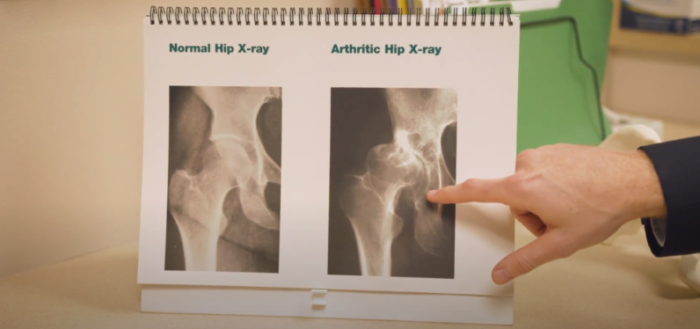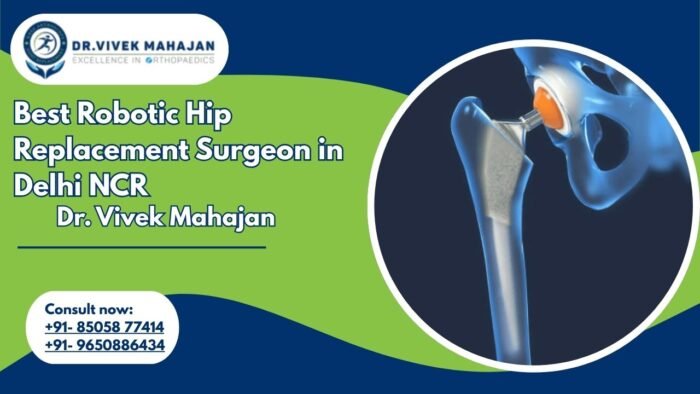The Natural Hip Joint
The hip joint plays an important role in movement and maintaining balance. It also supports weight while we are standing, sitting, running or walking.
The hip is a ball and socket joint. It is made up of two parts. The first is the hip socket and the other is the thigh bone called the femur. A smooth material called cartilage lines the socket, allowing the ball to move smoothly inside the socket.
In a diseased hip, the cartilage wears out resulting in bone to bone contact that can be painful.
Who may need Hip Replacement Surgery?
Arthritic Hip
If you have severe hip pain that is limiting your mobility and affecting your daily functions, you may benefit from hip replacement surgery.
The following three are the most common causes of joint damage due to arthritis:
Osteoarthritis: A disease which involves the wearing away of the normal smooth joint surfaces. This results in bone-on-bone contact, producing pain and stiffness.
Rheumatoid Arthritis: The body’s immune system attacks and destroys the synovial lining covering the joint capsule, the protective cartilage and the joint surface. This causes pain, swelling, joint damage and loss of mobility.
Trauma related arthritis: Resulting from damage to the joint from a previous injury. It also results in joint damage, pain and loss of mobility.
Treatment Options: When medication, physical therapy and other conservative methods of treatment no longer relieve pain, total hip replacement may be recommended by your surgeon.
What is Hip Replacement Surgery?
Total hip replacement (THR) is the replacement of the ball and socket of the hip joint with implants. There are two main components used in total hip replacement. The acetabular shell replaces the hip socket. The femoral stem replaces the worn-out top of the femur. During surgery, the head of the femur (thigh bone) is removed and replaced with both a stem and socket, mimicking your existing anatomy.
Preparing yourself for Surgery
As with all surgeries, there are a number of things which the hospital will ask you to do to contribute to the success of the operation. If you have any questions or concerns, ask your doctor or hospital staff.
Your doctor may want you to meet the Physical Therapist (PT) before surgery. The PT may give you some tips on preparing your house for rehabilitation and how you should sleep, get out of bed, sit, stand, and walk following surgery.
Post Operative Physical Therapy
Your surgeon will recommend and supervise your hip rehabilitation programme, which typically begins 24 hours after surgery. Isometric exercises (tightening muscles without moving the joint) will begin while you are still in bed.
You will be instructed to do these exercises a number of times per day. The day after surgery, you will probably begin walking and exercising your hip joint.
Your Hip Replacement options at Ivy Elite Institute of Orthopaedics & Joint Replacement
There are many options possible in hip replacement surgery. There are different types of bearing options and stem options available.
Bearing Options
Bearing affects your hip’s mobility, flexibility and range of motion, as well as how the implant will stand up over time and how stable it will be in your body. Bearings can be made of metal, ceramic or polyethylene (medical grade plastic). At Ivy Elite Orthopaedics, we use the best in class bearing options that are proven to withstand the demands of your lifestyle.
Metal-on-polyethylene
Highly cross-linked medical grade plastic liners offer optimal levels of cross-linking crucial to maintain a balance between wear performance and mechanical strength of the implant, which ultimately determines the long term performance of your implant
Ceramic-on-polyethylene
The ceramic head is tougher than metal head and smoother which reduces friction, thereby resulting in lesser polyethylene wear
Ceramic is biologically inert, and hence well tolerated in the human body
Ceramic-on-ceramic
These bearings are especially relevant for high-demanding Indian lifestyles or for patients who would like to pursue an active lifestyle including activities like sports, yoga, hiking etc
Newer materials like delta ceramic
have been engineered to provide excellent WEAR properties along with unmatched STRENGTH and STABILITY
Uncemented Stem Options
With multiple stem choices in various sizes and configurations to suit your requirement, Ivy Elite offers you a range of options to restore your natural hip anatomy.
Bone Preservation Stem with special surface coating like Hydroxyapatite (HA) or Trebecular metal provides advanced fixation which is required for today’s more active patient.
Minimally Invasive THR
Minimally invasive hip replacement allows your surgeons to implant traditional hip components through one or two small (1.5 to 4 inch) incisions rather than the traditional 10 to 12 inch incision. The goal of minimally invasive hip replacement is to minimize the amount of soft tissue damage that occurs when a surgeon reconstructs a hip. The potential benefits of this approach include:
- Less bleeding during surgery
- Less post-operative pain
- Shorter recovery time & Smaller scars for improved cosmesis
Direct Anterior Approach (DAA)
In this we expose the hip from the front. This does not require resection of any muscular attachment making this a truly tissue sparing approach. This gives best control of cup placement, stability & leg length. The anterior approach when combined with a bone preserving femoral stem achieves both soft tissue preservation and bone preservation for the patient.
Verilast Technology for Hip
It is exclusive bearing combination of oxinium and highly cross linked polyethyline which provides low wear , high flexibility and real- life results. It is the best option for metal allergy patients restoring active lifestyle.
HIP Resurfacing
Hip resurfacing is an alternative to total hip replacement and primarily aimed toward young, active adults who, historically, have an increased risk for failure of a conventional hip replacement. It allows patients to have their arthritic, damaged hip bones reshape and resurfaced, not removed. Unlike conventional hip replacement in hip resurfacing only damaged cartilage is taken off from hip ball and socket. This is relaced by same size of metal ball and metal socket. This operation provides more durability and highactivity leveltoallpatients.



